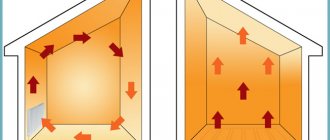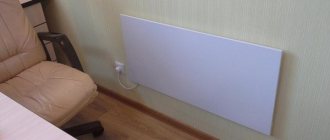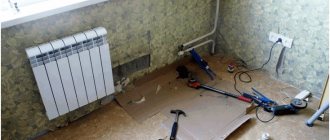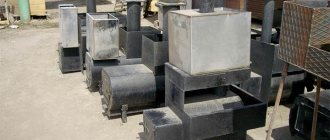In many apartments, a balcony or loggia serves as a dumping ground for all kinds of garbage, jars of pickles, and sports equipment. This happens because it is simply impossible to stay there in winter. If you save on insulating your balcony, then in the cold season the temperature on it can drop below 0 degrees.
Making a loggia into a full-fledged living space does not cost a lot of money or effort. To do this, it is not necessary to carry out a full renovation. But if possible, you need to think about heating a balcony or loggia already at the construction stage.
Insulation of the loggia during the construction phase
The tips in this section are suitable for “bare” balconies and loggias. The main difference between these two rooms is that the balcony protrudes from the facade of the house, and the loggia is separated from the main room by a wall. Read more in the article “What is the difference between a loggia and a balcony?”
The first thing you should decide is whether you are ready to start insulating the outside. This may require special equipment if you live above the 1st floor. Double-sided insulation is necessary for large rooms.
Seal all cracks with sealant (small) or foam (large). Heat escapes through them the fastest. Level all walls with putty and cement mortar. This increases the efficiency of thermal insulation.
Pay special attention to moisture insulation. Dampness attracts cold. Treat the internal and external walls with a moisture-repellent solution before installing heat-insulating panels.
Radiator on the balcony
A radiator on the balcony is very convenient. Judge for yourself: there’s something for everyone, and there’s no need to turn it on and off.
The forbidden fruit is bitter
However, this type of heating entails certain troubles. Already at zero degrees, the water in the radiator freezes and it can burst. And then all the lower floors will “float”.
That is why the Moscow authorities forbade placing the radiator on the balcony or loggia (Appendix 1 to the Moscow Government Decree of February 8, 2005 N 73-PP, “Reconstruction Measures”, 3 p.). And it doesn’t matter whether you insulated the balcony or not.
For more information on whether or not to remove heating from the legal side, read the article: How to circumvent the ban on removing heating from an apartment to a loggia? Heating without insulation is money down the drain. Which company should I contact for balcony insulation? And how much will it cost? You will find the answers on the site.
After insulation on the balcony, problems may arise: draft, fogging of windows, etc. You can deal with them! Details at the link:
Insulating materials
The following types of insulation are available on the market:
- expanded clay;
- mineral wool;
- expanded polystyrene;
- polyurethane foam;
- penofol.
Choosing the optimal material is easier than it seems.
Expanded clay
This is the cheapest material. Does not hold its shape, readily absorbs moisture. Durable, resistant to fire, mold, mildew. It is used to insulate the floor on the balcony when they want to save money.
Insulating the floor on the loggia with expanded clay
Mineral wool
Medium price material. Its slabs are very wide, so they are not suitable for small spaces. The ingress of moisture impairs the insulating properties. Mineral wool is environmentally friendly, fire-resistant, and creates additional sound insulation.
Balcony insulation with mineral wool
Expanded polystyrene
Expensive insulation, devoid of any shortcomings. The plates are easily attached to any surface using self-tapping screws. The best option for any room.
Polyurethane foam
Liquid insulation. Easily fills any cracks and cavities. Special equipment is required for installation. Dismantling presents some difficulties.
Penofol
Auxiliary thin heat and water insulator. It is used together with expanded polystyrene and mineral wool to create an additional air layer.
After you have chosen a thermal insulator, proceed with installation. First, all walls, floor, and ceiling must be covered with a layer of waterproofing made of polyethylene or foam foam, and the joints between the sheets must be glued with tape.
Balcony insulation with penofol
Then a metal or wooden frame is built (for more details, see the article “balcony sheathing”), into which the insulation will then be laid. The distance between it and the surfaces must be sealed with polyurethane foam. Next, the insulating boards are tightly laid. There should be no gap between them and the frame, otherwise all the work will go down the drain.
A rough covering of chipboard and plywood is built on top of this structure. You can install a heated floor on the loggia. Then finishing work is carried out.
Are we going against the law?
The law is not written for Russian people; heating is not a problem if you approach a complex task head-on. We will run the heating pipe or radiator from a centralized channel so that hot water flows throughout the house without complications. The beginning of the work will be to draw up an approximate budget, taking into account the cost of purchased materials, and make the necessary calculations. The second part will be checking the condition of the balcony; an inspection should be carried out for cracks, various holes, delamination of plastic and wood.
If the balcony is not glazed, then there is no point in insulating the room. First you need to glaze, it is advisable to install double-glazed windows that do not allow cold air, drafts, or frost to pass through. After installing the double-glazed window, you need to calculate the required materials, take measurements of the walls, establishing the required pipe length and the approximate size of the purchased battery. Many owners do not stop at one battery and go much further in their plans. It's nice to step on a heated floor in winter, and with central heating you can create a heated floor at no extra cost. If, after all, a warm floor is not needed, we move on to the next stage of preparing the repair. Repairs are done exclusively in the warm season to avoid flooding.
For repairs you will need the following materials:
- radiator or battery;
- pipe;
- plugs;
- equipment for system branching;
- tools.
The tools usually used are:
- sealing solution;
- Bulgarian;
- file;
- special polyurethane foam;
- metal plates;
- hammer drill
Using a hammer drill, holes are drilled in the balcony wall for mounting the future heating device. In the main pipe extending from the centralized system, using a grinder, we carefully cut out holes of the same size, trying to make them symmetrical. Fittings are installed into these cuts, always using a waterproofing layer. You can make it with your own hands using ordinary tow, securing it with insulating tape for reliability.
Do-it-yourself insulation of a balcony
If you don’t have time to do a full-fledged balcony repair with your own hands, use some folk methods of insulating a loggia. The temperature may rise by several degrees. Remember that this is a temporary measure. Such “tricks” cannot replace full thermal insulation.
Walk around the loggia with a candle or lighter. This will help determine from which joints and cracks the air is blowing. Seal them with putty. Draft is the worst enemy of heat.
Construct insulating panels from scrap pieces of foam. This material conducts heat poorly.
Such improvised insulation can be done in a few hours, but even this little thing reduces the chance of catching a cold from the cold coming from the loggia.
Adviсe
If you are choosing a heater for a balcony, consider the following parameters:
- Power. Affects the rate of air heating.
- Installation method. Consider in advance whether you can install the device on the balcony. If you cannot do this, choose simpler options, including an IR lamp or a fan heater.
- Functional features of the balcony. If you only want to warm the air for a few days, there is no point in buying expensive devices. If you use the balcony as a separate room, you can install a convector or a “warm floor” system.
- Safety. Do not install heaters with high heating temperatures. Especially if there are small children or pets at home. It is better to choose IR analogues.
Central heating radiators
Previously, it was possible to bring the central heating radiator onto the balcony without any problems. It was not forbidden to do the installation yourself. But now such actions are an administrative article.
The government has decided to limit the ability of residents of apartment buildings to change the layout of heating systems. This was done for security reasons. The battery on the loggia may freeze and burst.
Having an experienced lawyer and observing all the regulations, such redevelopment can be legalized through the court. This takes time and money, but as a result you get full heating of the loggia.
How to heat a balcony in winter: brief conclusions
A balcony with an installed heater can become a full-fledged additional room. Heat can be transferred into it in different ways, both simple and exotic. When using solar panels for an apartment, all the electricity for heating the loggia will be free, but the installation will be too cumbersome.
Innovative warm plinth - the ideal solution for the smallest balconies. According to the experience of most, the simplest way to heat a small room is a conventional battery, but you must obtain permission from the BTI for its installation.
Water floor heating
The water heating system is a polymer tube that is installed under the screed. It can be connected to both a gas boiler and a central heating system.
Don't forget to check the water heating on the balcony before screeding it. This can save you from paying compensation to your flooded neighbors.
Advantages - low price.
Flaws:
- damage to the tube can lead to a flood;
- fragility;
- Difficult to connect to central heating system.
Conclusion: a budget balcony heating system, which makes sense to install if you have an economical gas boiler.
Warm baseboards
Currently, good heating of the loggia can be achieved using warm baseboards. They are characterized by low energy consumption, look aesthetically pleasing and are easy to install
In addition, they do not take up extra space on the balcony, which is important given its small size
In fact, it is a low-mounted electric heater. However, the plinth system can also be made in the form of a water structure. Warm baseboards primarily heat the walls and prevent moisture retention on their surface. This system does not raise a lot of dust, as the air circulation is very smooth. In addition, in this case, warm air does not accumulate under the ceiling and does not contribute to drafts.
Modern technologies make it possible to choose a suitable heating system for a balcony, taking into account its characteristics and the purposes of arranging the room. The owner of the apartment can only choose the best option taking into account the allocated budget.
Electric floor heating
Electric balcony heating is more expensive and more reliable than water heating. Installation is almost no different from water systems. The only difference is that the electric floor must be connected to the power supply.
Advantages:
- durability;
- simple installation;
- precise temperature control.
Flaws:
- high price;
- needs stable mains voltage;
Conclusion: a durable system for apartments and small suburban premises.
There are two types of electric heated floors on the balcony:
- cable;
- infrared.
The latter type is more modern, but it is not without its drawbacks.
Cable electric heating
The heating element of such a system is a single- or two-core wire that has two layers of insulation. Cable heating on the balcony is not very economical.
Infrared electric heating
Thin thermal films of an infrared heating system consist of strips of graphite, isolated from each other and from the environment. This heating is 20% more economical than cable analogues, it is completely safe, but its service life is no more than 15 years.
Convector heater
A convection heater (thermal panel) works on a principle similar to a fan. But you won’t hear any noise from it, no matter how hard you try.
The convector can be left on 24 hours a day
Operating principle of the convector
In general, a convector has all the advantages of a 21st century heater. Heats up quickly, turns off when needed, and is easy to install. And you can place it wherever your heart desires: on the floor, wall and even ceiling! Depending on which part of the balcony needs to be heated.
However, the convector also has disadvantages . Firstly, it dries out the air, which can give you a headache. Secondly, like all electric heaters, it uses a lot of electricity. To heat 1 m2 of balcony per month in Moscow it costs at least 324 rubles! This is if the balcony is well insulated. If not, the costs will increase many times over.
Heating with electric appliances
If you were able to insulate your balcony, but you don’t have enough time or money to install a heating system, use heaters. Understanding all the variety of these devices can be difficult. Let's look at each of them in more detail.
Fan heater
A fan heater is an inexpensive option for auxiliary or spot heating on a loggia.
It consists of:
- housings;
- heating element;
- heat dissipation systems.
The body can be made of plastic or metal. After prolonged use, the plastic may burn and melt in some places. This does not affect the operation of the device, but still you should not spare money on purchasing a high-quality heater.
The key part of an electric fan heater is the heating element.
Main types:
- Spiral made of nichrome wire. It is used in the cheapest devices. It has a high temperature and very low heat transfer.
- Tubular heating element. A metal tube filled with a heat-conducting substance. It has average heating and heat transfer rates.
- Ceramic. Semiconductor heating element coated with glass ceramics. Has the highest heat transfer parameters.
For a small room, floor-mounted stationary or mobile fan heaters in a metal casing are suitable.
Convector for the balcony
A convector is a thermal panel, an automatic heater that gradually changes the temperature in the room. Cold air enters the housing, heats up, and then is blown back out. The heating element does not heat up above 100 degrees, which reduces the likelihood of fire in surrounding objects to a minimum.
The thermal panel may have the following heaters:
- Electric. Nichrome spiral, tubular electric heater, infrared element. Expensive models are characterized by increased efficiency and reduced energy consumption.
- Gas. Economical, but requires connection to a gas cylinder and a central gas pipeline.
A convection heater should be used to maintain a constant temperature on the balcony.
Oil radiator
An oil heater resembles a regular water battery, but works much more efficiently.
It consists of:
- metal radiator;
- mineral oil with high thermal conductivity;
- tubular electric heater;
- temperature and power control systems.
Radiators come in two types:
- panel;
- sectional.
Always choose a sectional oil cooler. This design has an increased area of contact with the surrounding air. There are mobile and stationary models. Choose equipment depending on the size of the balcony.
Fan heater on the balcony
The fan heater can be placed anywhere: on a windowsill, table or floor
This is a well-known compact device that sucks in cold air and delivers hot air into the room.
A fan heater on a balcony is often used only as an additional source of heat. Why? Of course, it warms the air quite quickly and well, but it is not designed for constant operation. And as soon as you turn it off, it will get colder on the balcony - and you won’t have time to gasp! Besides, it makes a lot of noise.
Balcony heating with electrical appliances
To heat the balcony, you can also use electric convectors, oil radiators and fan heaters.
Advantages of electrical appliances:
- mobility, used for large and small balconies, as well as for any other premises;
- temperature sensors installed on electrical appliances make their operation safe;
- can be turned on only when necessary;
- do not “dry” the air.
Heating a balcony with a convector is one of the simple and effective ways.
The use of such electrical appliances has one important drawback - a fairly large electricity consumption.
You will find more information about installing heated floors on balconies and loggias here.
The use of electrical appliances requires the presence of an outlet. Here you can read how to do it yourself.
If the room is warm even in winter, one of the ideas for arranging it could be creating a winter garden. Read more about this at the link https://balkonsami.ru/interer/ozelenenie/zimniy-sad-na-balkone-svoimi-rukami.html











